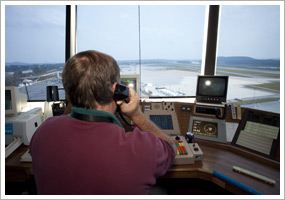| The following stories from the Oct. 14, 2011, edition of AOPA ePilot were provided to AOPA members who expressed an interest in the particular subject areas. Any AOPA member can receive information tailored to their areas of interest by updating their preferences online |
training tipsCheck in, speak up Use them to your advantage, and avoid developing the too-common habit of avoiding contact with ATC when the frequency crackles with communication. Sometimes, controllers say, they want to be in contact with VFR aircraft exactly when the local workload is at its peak. Surprised? Think about it from a radar approach controller’s viewpoint. Say you planned a flight from Brunswick Executive Airport in Maine to Limington-Harmon Airport. The route takes you near the northern boundary of Class C airspace centered on the Portland International Jetport. You determine that you can remain far enough away from the airspace boundary to make two-way radio communications with Portland Approach unnecessary. For extra reassurance you fly below the 1,500-foot floor of the outer ring until well clear. You are monitoring the approach frequency, and yes, there is a push on. Most aircraft are landing on Runway 11, but some are opting for Runway 18, accepting clearances to land and hold short of the runway intersection. Just before you fly across the Runway 18 final approach course, you spot one of the inbound aircraft dead ahead (at your altitude). That’s when a radar controller would want to be in contact with you. In that situation, you are having an effect on the flow. How? California air traffic controller Paul Langston discussed a similar scenario with a pilot who visited his ATC facility. “We have to restrict all of the arrivals inbound on that approach to avoid his aircraft,” he said in this AOPA Online safety article. “I asked him why he didn't just call us for VFR traffic advisories, and he said, ‘I didn't want to be any trouble.’ I explained to him that it would be much easier for us—and ultimately safer for him—if he would let us give him flight following.” Remember, if ATC is not talking to you, they may be talking about you to another aircraft. By checking in and speaking up, you will help reduce the workload for everyone else in the airspace you share. For more insights into how ATC works, review the Air Safety Institute’s “Ask ATC” presentation on flight following.training productsDiscount offered on Jeppesen ordersLooking to do some shopping? JeppDirect is offering a $20 discount on any order over $150 when you use the code OCTSAVE at checkout. The offer is good until Oct. 31, and cannot be applied toward NavData, JeppView MFD, or renewal service orders. See the website for more information.
Note: Products listed have not been evaluated by ePilot editors unless otherwise noted. AOPA assumes no responsibility for products or services listed or for claims or actions by manufacturers or vendors. final exam
Question: Since my student pilot days, I have wondered exactly how fast or slow I should taxi and what speed is considered safe. Can you shed some light on this subject?
Answer: For someone just learning, a fast-paced walk is probably fast enough until that person gets the hang of it. However, in most cases, it is difficult to dictate a single rule for what is considered a safe speed. The FAA sums it up quite well in the Airplane Flying Handbook. “What is reasonable and prudent under some conditions may be imprudent or hazardous under others. The primary requirements for safe taxiing are positive control, the ability to recognize potential hazards in time to avoid them, and the ability to stop or turn where and when desired, without undue reliance on the brakes. Pilots should proceed at a cautious speed on congested or busy ramps. Normally, the speed should be at the rate where movement of the airplane is dependent on the throttle. That is, slow enough so when the throttle is closed, the airplane can be stopped promptly.” A pilot also should consider FAR 91.13, which addresses operating an aircraft in a careless or reckless manner whether in the air or on the ground. Also see “Tackling taxiing” on AOPA Online, which has tips for smooth techniques for surface operations.
Got a question for our technical services staff? E-mail [email protected] or call the Pilot Information Center, 800/872-2672. Don’t forget the online archive of “Final Exam” questions and answers, searchable by keyword or topic. |
 High-traffic airports have busy times and slack times. The hectic morning and afternoon arrival and departure periods may be separated by intervals of relative calm, providing opportunities to gain comfort transiting the airspace while making use of workload-permitting
High-traffic airports have busy times and slack times. The hectic morning and afternoon arrival and departure periods may be separated by intervals of relative calm, providing opportunities to gain comfort transiting the airspace while making use of workload-permitting 

